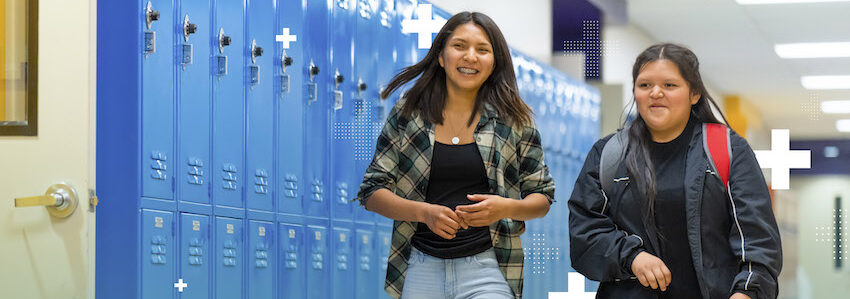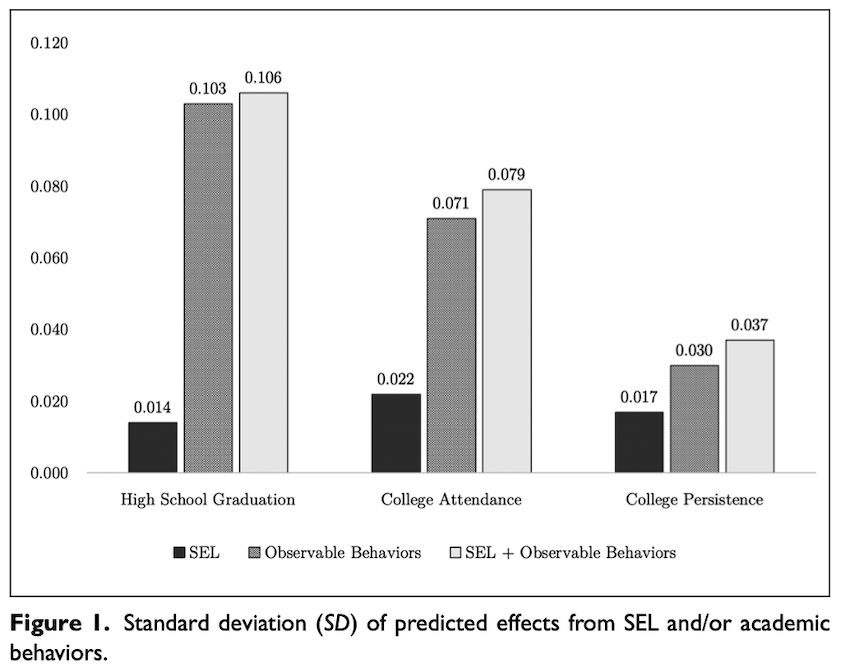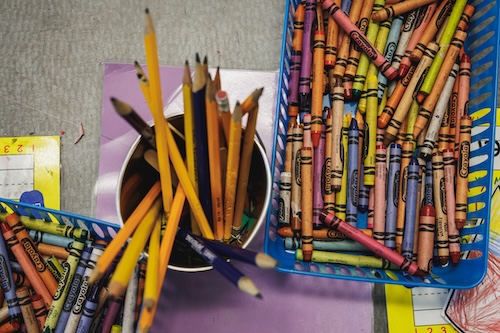
The percentage of students displaying chronic absenteeism—defined as missing 10% or more of school for any reason—nearly doubled in the wake of the COVID-19 pandemic. The most recent data suggests those rates may be improving somewhat, but progress has been slow.
Attending school is important. So much so that in January, the Biden administration recommended increasing student attendance as one of its three evidence-based strategies that improve student learning.
What the research tells us about chronic absenteeism
In a new research paper, Jing Liu, Monica Lee, and I show that academic behaviors— including showing up to school regularly—are highly predictive of three longer-term outcomes:
- Graduating from high school
- Attending a four-year college
- Persisting in college more than one year
We used detailed longitudinal data from ninth-graders in a large urban school district in California to evaluate the degree to which observable academic behaviors and student self-reported social-emotional learning (SEL) skills predict future educational attainment.
We defined “academic behaviors” as behaviors students exhibit in school, including attendance, chronic absenteeism, and rule-breaking resulting in suspension. Our definition for “SEL” is in line with the definition published by the Collaborative for Academic, Social, and Emotional Learning (CASEL): “SEL is the process through which all young people and adults acquire and apply the knowledge, skills, and attitudes to develop healthy identities, manage emotions and achieve personal and collective goals, feel and show empathy for others, establish and maintain supportive relationships, and make responsible and caring decisions.” We compared academic behaviors, including full- and part-day school absenteeism and suspensions, in ninth grade against SEL measures including self-management, self-efficacy, growth mindset, and social awareness.
Overall, the academic behaviors were much more predictive than SEL skills across the three longer-term outcomes. Specifically, we found that conditional on students’ achievement and demographic characteristics, ninth-grade academic behaviors were seven times more predictive of high school graduation, and two to three times better at predicting college attendance and persistence. Among the various academic behaviors, part-day absenteeism, or class skipping, is the most highly predictive of the longer-term outcomes.
In the sections below, I break down three important lessons for policymakers looking to understand—and ultimately improve—student outcomes.
1. Academic behaviors are easier to measure than SEL
Our research found that academic behaviors and SEL skills are related and that a student’s self-perceptions can manifest through academic behaviors such as attending school regularly and avoiding disciplinary infractions. Conversely, disengagement is commonly linked to feelings of isolation or lack of support, bullying, and a lack of sense of safety. Furthermore, schools with exclusionary discipline policies tend to have students with lower rates of academic connection and sense of belonging in their classrooms. On the positive side, programs focused on SEL development and restorative justice practices have led to reductions in absenteeism and/or suspensions.
However, academic behaviors and SEL are also not perfectly correlated, and they typically vary in terms of how the data is collected and the intended uses by districts. For example, we found that academic behaviors are far easier to collect since many states and districts already mandate the collection of most or all the necessary data.
Ninth-grade academic behaviors were more than seven times more predictive for high school graduation than the self-reported SEL scores.
Our study was only possible thanks to our district partner collecting survey responses on four SEL constructs:
- Growth mindset
- Self-efficacy
- Self-management
- Social awareness
The district administered an annual survey asking students to respond to a maximum of eight questions for each of the four SEL constructs, including how much they agreed with statements like the ones that follow:
- “I am capable of learning anything.”
- “I can do well on all my tests, even when they’re difficult.”
The district in our study was already collecting this data, but cost may be a barrier for less-resourced schools and districts. We observed a 67% response rate on the SEL survey.
In contrast, the academic behavior data we used may already be collected by many states and districts. Chronic absenteeism is easily observable and measurable for all students, making it less challenging than other measures to use as a proxy for disengagement. Attendance is marked daily, if not multiple times a day, for high school students and it is kept as administrative data. Additionally, school staff also tend to mark reasons why a student has missed school, such as for excused and unexcused reasons; this helps provide an understanding of whether the absence occurred due to legitimate reasons.
In sum, academic behaviors are easier to measure than SEL skills, but little is known about whether measures of SEL skills uniquely predict educational attainment such that their inclusion in early warning systems or accountability models would provide valuable information above and beyond typically included measures like absenteeism rates.
2.Academic behaviors were more predictive than SEL skills
The research literature consistently finds that attendance, discipline rates, and completion of certain high-stakes academic coursework are the strongest predictors of high school graduation above and beyond standardized test scores. We extended these results by comparing academic behaviors and SEL skills.
We found the predicted variance was much higher for academic behaviors, regardless of which long-run outcome we use. The chart below, figure 1 in our paper, shows the results. The predictive power of SEL skills is in black, compared to the observable academic behaviors in dark gray. In light gray we show a model that combined both sets of measures.

As the chart shows, ninth-grade academic behaviors were more than seven times more predictive for high school graduation than the self-reported SEL scores. This contrast becomes weaker for the longer-term outcomes like college attendance and college persistence, but academic behaviors still exhibit predictive power two to three times larger than SEL skills. The chart also shows that SEL skills added very little predictive value over and above the measures of attendance and other behaviors (the light gray versus the dark gray bars). Academic behaviors were better as a standalone measure, and they largely capture any unique contributions the SEL survey added.
Unfortunately, all our measures of noncognitive skills got weaker the further out we looked. When trying to predict college persistence, models that included academic behaviors, SEL skills, or both did little better than provide a baseline model that used only student demographics and ninth-grade GPA data. Importantly, we did see one notable difference when we looked across student groups: academic behaviors were once again much better predictors of high school graduation rates for low-achieving students, but we also found suggestive evidence that SEL skills played a bigger role for the postsecondary success of lower-performing students.
3. Policymakers may want to consider looking at partial attendance
As policymakers work to address the current spike in chronic absenteeism, our research suggests they should also look more closely at partial attendance. Students who miss only a class or part of the day may not show up in the chronic absenteeism numbers, but they may still be at risk of longer-term consequences.
Our data was pre-pandemic, and in our sample the average student missed about six full school days during ninth grade. (These numbers likely pale in comparison to the current absenteeism spike.) In contrast, part-day absenteeism was much more prevalent: the average student accrued about 17 part-day absences, or close to three times as many as full-day absences.
Moreover, part-day absences were a stronger predictor of longer-term outcomes than full-day absences were. The effects were especially large for our two post-secondary outcomes, which suggests that more granular measures of academic behaviors, which might already exist in existing school administrative data systems, could provide more useful information about student future academic trajectories that is currently not captured by more crude, commonly used measures such as full-day absences or suspensions.
In closing
Our study results should not be taken as evidence that SEL skills don’t matter, and we hope practitioners continue their efforts to measure and promote SEL skills. However, our findings start to unveil the untapped potential of developing more fine-grained behavioral measures, which are already being collected by school administrative data systems.
Given how strongly partial-day absenteeism predicts long-run outcomes, policymakers should consider tracking and monitoring it more closely than most currently do. Other academic behaviors, such as tardiness, office discipline referrals, and participation in extracurricular activities, are also relatively easy to measure and potentially contain rich information about students.







